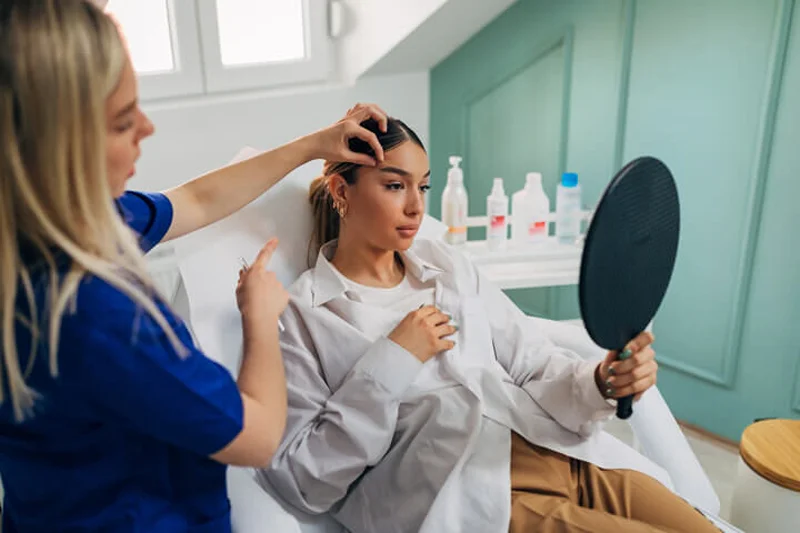Side Effects of Tear Trough Fillers

A tear trough is a deep groove that runs from the lower eyelid to the upper cheek. It may produce a shadow behind your eyes, giving you an exhausted appearance. Some people believe that their tear troughs make them appear older. To combat this, many people opt to get fillers to reduce the depth of a tear trough.
So are there any side effects associated with tear trough fillers? Like many other types of facial fillers, people who undergo this treatment may experience side effects. Before undergoing treatment, it’s critical to understand the procedure and any potential problems by consulting with a trusted aesthetic practitioner.
Learn More: Side Effects of Juvéderm and How to Deal With Them
What is your perfect cosmetic filler? Whether in your lips, cheeks, or anywhere else, our providers know exactly how to make you look your best. Call us today to learn more.
Side Effects and Complications
Tear trough fillers are generally considered safe. They’re also less invasive than rip through operations like fat grafting and fat repositioning. This is not to claim that it is without adverse effects.
Tear trough fillers are most likely to go wrong when conducted by inexperienced practitioners who lack a thorough understanding of patient anatomy, use the incorrect type of filler, or do not properly choose patients who are candidates for this type of therapy.
The tear trough is a difficult place to treat since the tissues are thinner than in other areas of the face, making any issue much more evident. Similarly, because the tear trough is so close to the eye, it’s best performed by a qualified practitioner to navigate the complicated anatomy of the eye area. Consult with an oculoplastic surgeon to properly manage any post-operative eye-related issues.
1) Bruising and Soreness
The skin around your eyes is extremely sensitive and densely packed with blood vessels. Because of the thin skin, this area is more prone to bruising, which is one of the most prevalent side effects of the treatment. In cases of bruising, it should disappear after the first week. Soreness may also happen, but this should resolve a day after the treatment.
2) Swelling
Swelling is another typical side effect. Like bruising, it should resolve within the first week. However, some swelling may occur in the mid-cheek region in some people. This occurs when the filler is injected inappropriately above the orbicularis retaining ligament or is inserted too superficially beneath the skin. Due to the fact that some fillers attract water, they might cause swelling around the eyes if the solution is applied too close to the surface.
3) Tyndall Effect
If your fillers aren’t properly placed, you may encounter the Tyndall effect, which affects how light scatters under specific conditions. In the case of under-eye fillers, this results in a mild bluish tint to the area. Fortunately, this can be corrected with a hyaluronidase injection, which is an enzyme that breaks down the hyaluronic acid in the filler.
4) Nodules and Puffiness
Another possible, more serious adverse effect is the formation of nodules following the injection, which can also be treated with hyaluronidase. A related complication, which arises from having too much filler injected into the tear trough, is puffiness. These two effects become more visible when the patient smiles or when the area is viewed from above.
5) Blocked Arteries
One of the most significant (and uncommon) side effects of the treatment is having filler injected into a blood artery. This can cause a blood artery to get blocked, resulting in blindness. This is why you should always have injectables done by a board-certified dermatologist or cosmetic surgeon, so you can avoid dealing with unnecessary complications that may cause permanent damage to your health.
Other Uncommon Side Effects and Complications
These other concerns related with tear trough fillers, albeit infrequent, should be considered while deciding on treatment:
- Post-procedure infection, which may necessitate medications and can occur up to six months after a procedure.
- Sensitivity reactions, which include redness, swelling, and discomfort and can occur long after the operation.
- Increased hyperpigmentation, particularly in the treated area.
- Occlusions, which can cause skin discoloration.
What to Expect Before Treatment
Prior to the treatment, your dermatologist or cosmetic surgeon typically meets with you for a consultation. This will allow them to ascertain the exact treatment for your tear troughs and determine whether or not you’re a good candidate for fillers.
What to Expect During Treatment
For the most part, patients don’t get numbing drugs during this surgery, but you can absolutely request them if you choose. Simply be aware that doing so will require you to wait 30 to 40 minutes for the numbing to take effect, so delaying your appointment slightly. Without the numbing drug, the session should take no more than 15 minutes.
There are two distinct ways for the injection. While some dermatologists and cosmetic surgeons prefer to use the tiny needles included with the fillers, an increasing number of dermatologists and cosmetic surgeons prefer to use a cannula.
The traditional method is to use the needle alone. The cannula functions similarly to a dull straw, allowing the needle to pass through, requiring only one poke. Some studies claim that this allows for more precise placement with less swelling and bruising.
Meanwhile, the most critical element when considering under-eye fillers is to consult with an expert medical specialist who is familiar with the complicated anatomy surrounding your eye.
A medical practitioner will examine your lower eyelids before administering tear trough fillers. They will also examine your skin’s texture and thickness, and assess which kind of dermal filler is ideal for you.
Your procedure will be carried out in a medical office. Here’s what to expect:
- To avoid infection, a medical expert disinfects the skin. To prevent bruising, a topical anesthetic may be applied to the area, or an ice pack may be placed on your lower eyelids. This numbs the region and reduces the likelihood of bruising.
- They next prepare a syringe with the filling inside. The syringe is attached to either a blunt or a sharp needle, depending on their preference. The filler is injected into the skin beneath your lower eyelid.
- They slowly withdraw the needle while they inject the filler. They gently massage the area to distribute the filler. The technique is then performed beneath the opposite eyelid.
Learn More: What’s The Best Filler for Deep Forehead Wrinkles?
What to Expect After Treatment
Avoid touching the region for at least 24 hours following your procedure. To avoid infection, refrain from using cosmetics or skincare products until the next day. For the first day, ice the area in ten-minute sessions every few hours and abstain from any workouts that may boost your heart rate.
Follow all post-treatment instructions, which should include the following:
- For the next 24 to 48 hours, avoid strenuous activities.
- Avoid sleeping on your stomach.
- Massage any lumpy places with your fingers.
The outcome of tear trough filler injections varies based on the individual’s particular condition and the type of filler used. The results are obvious immediately following the operation, albeit some swelling may obscure the results shortly following the injections.
The majority of tear trough fillers last between 6 and 12 months on average but may last longer in some individuals. It varies by individual and the rate at which the filler is absorbed back into the body.
Alternatives to Tear Trough Fillers
Tear trough fillers aren’t for everyone. If you’ve been evaluated to be unfit for tear trough fillers, then it’s time to look for other options. Fortunately, there are many alternatives to fillers that can adequately address your tear trough concerns, each with its own set of benefits and drawbacks.
1) Over-the-Counter Creams
The hyaluronic acid in anti-aging lotions can plump up the skin when administered topically. These serums or lotions are usually less striking than fillers, but they cost less and don’t carry the same hazards.
Antioxidants, retinoids, and peptides (particularly collagen peptides) may help plump the skin in the tear trough area, decreasing hollows and dark circles.
2) Skin Tightening/Eye Lift Surgery
If tear trough filler injections don’t work, your doctor may suggest skin tightening or eye lift surgery.
Laser skin resurfacing can help tighten the skin around the eyes. You may have a thin layer of skin removed from beneath your eyes to promote new skin growth and collagen production. Other lasers only heat the skin, encouraging new collagen formation and tightening.
Eyelid surgery is more invasive than fillers. Your doctor may remove extra skin, do fat grafting, or a combination of both. Surgical methods are riskier, costlier, and need a 3-week recovery period. With adequate skincare, corrective cosmetic operations may last longer than dermal filler injections.
Read More: Side Effects of Under-Eye Fillers
The Best Tear Trough Filler Treatments at aNu Aesthetics

Tear trough fillers work quickly to diminish the appearance of hollows, bags, and dark circles. In addition to being less expensive than most surgical procedures, they have fewer dangers and faster recovery times than over-the-counter creams. However, like many cosmetic or aesthetic procedures, caution must be taken when getting tear trough fillers. The range of side effects can go from mild to incredibly concerning. This is why it’s important to have trained professionals do these treatments.
At aNu Aesthetics, we’re known for providing exceptional patient care in a professional environment. Our highly-trained and experienced staff will definitely ensure that you have a safe and hassle-free experience. Contact us now to schedule your first appointment.
What is your perfect cosmetic filler? Whether in your lips, cheeks, or anywhere else, our providers know exactly how to make you look your best. Call us today to learn more.